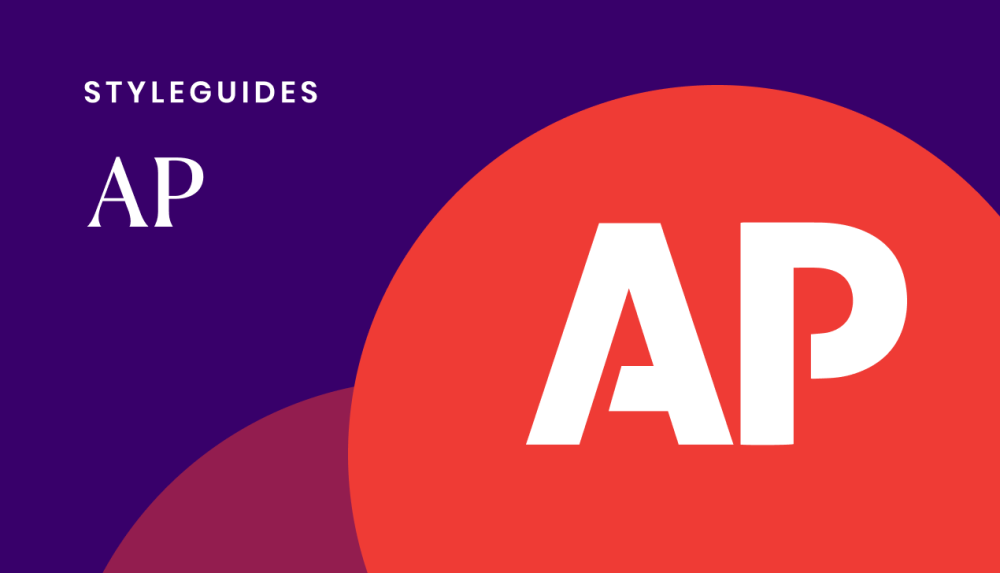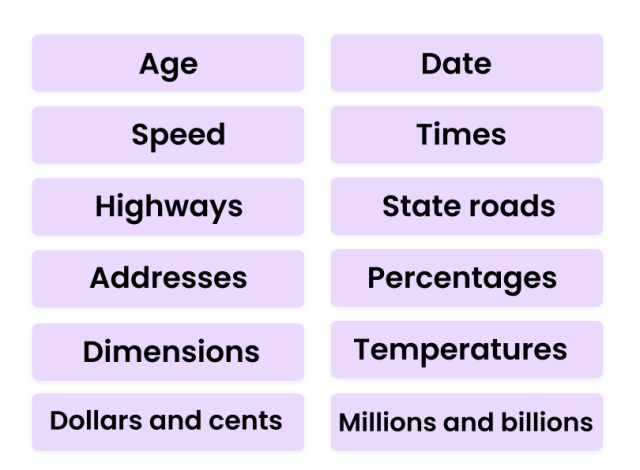Words at work
– 12 min read
A comprehensive guide to the AP style of writing

The Associated Press Stylebook (a.k.a. AP Stylebook) is to journalists what HubSpot is to content marketers: the industry “bible.”
For more than 50 years, journalists have turned to AP Style for everything from grammar and style rules to trusted best practices. But for content writers and content marketers who aren’t formally trained in AP style, mastering the 500-page book, which is updated annually can be a herculean undertaking.
Fortunately, the nuts and bolts of AP style can be simplified into five main categories: numbers, dates, citations, capitalization, and headlines. By following AP guidelines for these elements, writers can enforce a sense of consistency that makes content easier to write and more pleasant to read through.
Editor’s Note: Looking for a simple way to make sure you and your team of writers are using the AP Style correctly? An AI writing platform, such as Writer’s app can ensure that your writing is consistent.Sign up for a free trial here.
What is AP style?
Associated Press (AP) style is the go-to English style and usage guide for journalism and news writing, such as magazines and newspapers. AP style dictates basic rules for grammar and punctuation, as well as specific styles for numbers, spelling, capitalization, abbreviations, acronyms, and much more.
The ins and outs of AP style can be found within the “Associated Press Stylebook and Briefing on Media Law.”. While the AP style guide was originally sold as a handbook for reporters, it’s rapidly become the leading reference for the majority of public-facing communication, including websites, white papers, and press releases to reflect new additions to the English language or address common verbiage seen in the media. For instance, the latest edition included new or revised entries for digital wallets, smart devices, and the novel coronavirus. If you’re ever in doubt about acceptable word use or modern jargon, the style guide is continuously refreshed to keep up with trends.
What are the benefits of using AP style?
AP style was originally developed with print media in mind. Back in the 1950s, when the guide was first published, writing space was limited, and it was extremely costly for news outlets to correct errors.
Today, the ease of online media outlets and blogs makes available space much less of an issue. However, that’s not to say that many of AP’s earliest benefits for journalists don’t still benefit the content marketers of today.
For one, the continued use of AP style means that writing style is uniform across all outlets. This helps ensure that content marketing is easy to read and concise, so it can connect with a wide audience. Plus, it creates a writing style readers can come to expect and recognize, assisting in branding efforts.
Secondly, content marketers can benefit from the “inverted pyramid” approach of AP style. The most important information is presented first, in the lead or introduction. Supporting information is presented lower in the copy, and the least important details are always included last.
Of course, this approach stems from the days where newspapers were printed with very limited space. With the “inverted pyramid” thought process, printers could simply cut off the bottom of a story if it didn’t fit in the allotted column. Today, content marketers should always present their audience with the most important information first, so if a reader leaves the page mid-way through, they’ve at least instilled the most relevant part of their message.
AP style cheat sheet
Unless you’re prepared to invest several hours into scanning hundreds of pages in the AP style guide, it’s easier to review the most common best practices for AP style. When it comes to content marketing, best practices typically revolve around numbers, dates, citations, capitalization, and headlines.

AP style guidelines for numbers
According to AP style, content writers should spell out numbers one through nine and use numerals for numbers 10 and higher. But readers be warned, there are exceptions to this rule.
Instances in which a writer should always use numerals instead of writing out numbers include:

However, there are also a few exceptions to AP style guidelines for numbers. Writers should always spell out numbers used at the beginning of a sentence, such as, “Forty students…” but years should always be written with numerals, such as, “1980 was…”
When making a number plural, a writer should add an s but no apostrophe. This rule applies to decades as well. So, a content marketer could write that they rolled all 7s in dice or they loved music from the 90s.
AP style guidelines for dates
When it comes to dates, writers should always use a numeral without the addition of “st, nd, rd, or th.” When a month is used with a specific date, the month should be abbreviated. In other words, a writer would refer to New Year’s Day as Jan. 1 — not January 1, January 1st, or January first.
Months that should be abbreviated when used in a full date include:
February (Feb.)
If a writer is using only a month and a year to refer to a time period, the month should be spelled out fully. There should be no comma between the month and year. For example, the second month of this year would be written as February 2020.
If a phrase refers to a month, day, and year, the year should be separated with a comma — i.e. March 10, 1990, or Oct. 14, 1995.
For days of the week, you should always capitalize the specific day but never abbreviate it.
In addition, if you are referring to a specific day that is more than one week away, you should also reference the month and year.
When it comes to time, even hours do not require a colon and two zeroes at the end. For instance, “eight o’clock” in AP style is simply 8, not 8:00. To distinguish between night and day, a writer should always include “a.m.” or “p.m.” after the numeral. However, it’s best to use “midnight” or “noon” instead of 12 a.m. or 12 p.m.
AP style guidelines for citations
Most writers are familiar with MLA or APA citations used in high school and college essays. Unlike these style guides, AP style doesn’t specify page formatting and citation rules quite as harshly. However, it does provide a standardized way of referencing people, dates, and things.
When referencing people, always use the person’s first and last name upon the first mention. Only use the person’s last name on the second reference. It’s unnecessary to utilize courtesy titles, such as Miss, Ms., Mrs., or Mr., unless they’re part of a direct quote or necessary to differentiate between individuals with the same last name (i.e. Mr. and Mrs. Smith).

Always be sure to use the word said to attribute a quote to an individual. Alternatively, writers can substitute ‘said’ for a more impactful verb, such as exclaimed, yelled, or asked. Punctuation for quotes should always remain within the quotation marks — “Like that?” you asked and “Like this,” I said.
When citing print and news articles on the first mention, writers must include:
1. The name of the author or writer
2. Title of work
3. Date of work
4. Where it was published
Once the writer fully identifies the source, including the name, title, and date of publication, it’s only necessary to identify the source by their last name upon second or later mentions.
For books, writers must include the author and title of the book as well as the year it was published on the first mention. Upon second or later mention, only the author’s last name is necessary.
For websites, citation varies slightly in AP style. A writer should only use a website citation when citing a study or a statistic. An article on the website would simply be cited as an article.
For instance, Statista.com is loaded with statistics. To cite this source, you would identify the name of the website and briefly describe it — such as, “According to Statista.com, which collects the results of national, state and local surveys, remote work grew by 80 percent in four years.”
In content marketing, proper attribution should also include a link back to the original website source whenever possible.
AP style guidelines for capitalization
AP style incorporates what’s known as a “downstyle” for capitalization. This means that words are all lowercase unless a specific rule says to capitalize them, such as proper nouns like specific state names in the United States.
For example, when it comes to state names, if the state is used upon first reference in the description by itself, you should spell it out.
However, if the state and city are used together, you should abbreviate the state. For example, Tallahassee, Fla., Montgomery, Ala., Tulsa, Okla., Madison, Wis., or Little Rock, Ark.
However, there are 8 states that should always be spelled out in full and never abbreviated, which include Alaska, Hawaii, Idaho, Iowa, Maine, Ohio, Texas, and Utah.
Some additional capitalization rules to be aware of include:
Common nouns such as river or street should be capitalized only when used as part of a proper name for a person, place, or thing, such as the Colorado River or Democratic Party.

The seasons should only be capitalized when used in a proper name, such as the Winter Olympics. Similarly, directional indicators such as east or west should all be lowercase — unless they refer to specific geographic regions or popularized names for certain regions, such as the “the Midwest.”
For the most part, job descriptions should never be capitalized. For instance, police officers, teachers, or accountants do not need to be capitalized in AP style. However, formal titles, such as Doctor Evans or President Lincoln, should be capitalized when they come directly before a name.
AP style guidelines for headlines
AP style guidelines for headlines may differ from what certain content writers or marketers are used to. Generally speaking, AP style uses title case for headlines, which means all words are capitalized except for certain short words, such as articles and short prepositions.
In AP style, headlines capitalize the first word, proper names, or proper abbreviations, verbs, pronouns, adjectives, and adverbs.
If that sounds like a lot to remember, think of it this way instead: as a general rule of thumb, any word that’s three letters or less should not be capitalized.
Words that should not be capitalized include:
- Articles (a, an, the)
- Short (fewer than 5 letters)
- Coordinating Conjunctions (and, but, for)
- Prepositions (at, by, from, etc.)
AP style writing examples
Now that you’re more familiar with AP style for various aspects of content writing let’s combine a few style guidelines to demonstrate best practices.
Best practices for numbers
Do you have five minutes to discuss numbers? Yesterday, I spent $3 on a slice of pizza. Then, my 13-year-old niece asked me to order 11 pizza pies for her friends. So, I spent another $150 on pizza. I predict that by the time I’m 70-years-old, I’ll have spent $1 million on pizza!
→ Numbers less than 10 are spelled out fully.
→ Numbers greater than 10 expressed with numerals.
→ Ages, dollar, and millions are expressed with numerals.
→ When referring to a person’s age as an adjective, make sure to use hyphens.
Best practices for dates
Can you believe it’s Jan. 1 already? I’m planning for a party on Feb. 5, 2021. I’m hoping that by February 2021, there will be more venues available. The ideal time slot for the party is 1 p.m., but I could settle for noon.
→ Specific dates should be abbreviated, without the use of “st, nd, rd, or th.”
→ Time periods should use the full month and year with no comma.
→ Time should include a.m. or p.m., aside from noon and midnight.
Best practices for citations
→ Citing an article must include the author’s full name, article title, where it was published, and when.
→ Use the author’s full name on first mention and last name on secondary mention.
→ Use “said” to attribute a quote and keep punctuation within the quotation marks.
Best practices for capitalization
I traveled south down the Colorado River to reach the area of the Midwest I wanted to see. It’s a shame I missed the Winter Olympics this year. I heard Doctor Smith attended. My favorite athlete didn’t participate. They visited a doctor last fall for a bad injury.
→ Common nouns are only capitalized when used as part of a proper name
→ Directions and seasons are only capitalized when used in a proper name.
Best practices for headlines
How to Decorate the Perfect Christmas Tree
Top Tips for Writing an Ebook from Beginning to End
Stop by the Local Farmers’ Market this Weekend
→ The first and last word in a headline should always be capitalized.
→ Short words (less than three letters) are typically lowercase.
→ Articles, prepositions, and coordinating conjunctions are typically lowercase.
Best practices for referring to technology and social media
It can be hard to keep up with the proper AP Style guidelines for common tech terms.
→ Use iPhone and iPad.
→ Website is one word, not two words. However, a web page is two words.
→ Hashtag is one word, along with email and smartphone. However, there should be a hyphen for the following words, such as e-book and e-reader.
→ When referring to a website in a post, reference the site’s title and not the full webpage address. For example, it is Google NOT www.Google.com
From a more concise writing style to a simplified approach to content, there are several benefits of adapting to the AP style. Fortunately, content writers and content strategists don’t need to memorize all of the ins and outs of AP style to master the basics of clearer writing. By adding the details to your style guide and using an AI writing platform, like Writer, you can incorporate these best practices seamlessly across each content asset you produce.







